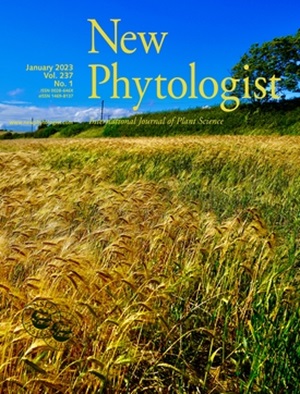番茄黄化病毒致病性因子p22通过破坏番茄WRKY81的功能干扰脱落酸介导的抗病毒防御
IF 8.1
1区 生物学
Q1 PLANT SCIENCES
引用次数: 0
摘要
脱落酸(ABA)对植物抵抗生物和非生物胁迫至关重要,但其在病毒感染过程中的调控及其在抗病毒防御中的作用尚不清楚。在这里,我们报道了SlWRKY81的过表达导致ABA积累增加,而沉默SlWRKY81则降低了番茄植株中ABA的水平。进一步分析发现,SlWRKY81直接结合ABA生物合成基因SlABA2和SlABA3的启动子,激活其表达。番茄萎黄病毒(ToCV)侵染显著抑制ABA含量。同样,tocv编码的p22致病性蛋白在番茄中的异源表达导致aba缺失表型。此外,外源ABA的应用显著提高了对ToCV的抗病毒防御,而ABA缺乏的番茄突变体对ToCV表现出更高的敏感性。虽然已经证明ABA通过微调免疫调节病毒积累,但病毒对抗机制尚不清楚。我们发现p22抑制了SlWRKY81的核定位。此外,p22进入细胞核,破坏SlWRKY81的DNA结合活性,同时通过泛素- 26s蛋白酶体途径加速其降解,其机制尚不清楚。我们的研究结果揭示了SlWRKY81在调节番茄ABA生物合成中的积极作用,并揭示了病毒致病性因子干扰ABA介导的抗病毒防御的机制。本文章由计算机程序翻译,如有差异,请以英文原文为准。
Pathogenicity factor p22 of tomato chlorosis virus interferes with abscisic acid-mediated antiviral defenses by disrupting the function of WRKY81 in tomato
- Abscisic acid (ABA) is essential for plant resistance to both biotic and abiotic stresses, but its regulation during virus infection and role in antiviral defense remain poorly understood. Here, we report that overexpression of SlWRKY81 led to increased ABA accumulation, whereas silencing SlWRKY81 reduced ABA levels in tomato plants. Further analysis revealed that SlWRKY81 directly binds the promoters of ABA biosynthesis genes SlABA2 and SlABA3, thereby activating their expression.
- Infection by tomato chlorosis virus (ToCV) inhibited ABA content significantly. Consistently, heterologous expression of ToCV-encoded p22 pathogenicity protein in tomato resulted in an ABA-deficient phenotype. Additionally, exogenous ABA application significantly improved antiviral defense against ToCV, whereas ABA-deficient tomato mutant sitiens exhibited higher susceptibility to ToCV.
- While it has been demonstrated that ABA modulates virus accumulation via fine-tuning immunity, viral counter-mechanisms remain unclear. We demonstrate that p22 inhibited the nuclear localization of SlWRKY81. Furthermore, p22 entered the nucleus and impaired the DNA binding activity of SlWRKY81, simultaneously accelerating its degradation through the ubiquitin-26S proteasome pathway via an unknown mechanism.
- Our findings uncover the positive role of SlWRKY81 in regulating ABA biosynthesis in tomato and reveal mechanisms by which a viral pathogenicity factor interferes with ABA-mediated antiviral defenses.
求助全文
通过发布文献求助,成功后即可免费获取论文全文。
去求助
来源期刊

New Phytologist
生物-植物科学
自引率
5.30%
发文量
728
期刊介绍:
New Phytologist is an international electronic journal published 24 times a year. It is owned by the New Phytologist Foundation, a non-profit-making charitable organization dedicated to promoting plant science. The journal publishes excellent, novel, rigorous, and timely research and scholarship in plant science and its applications. The articles cover topics in five sections: Physiology & Development, Environment, Interaction, Evolution, and Transformative Plant Biotechnology. These sections encompass intracellular processes, global environmental change, and encourage cross-disciplinary approaches. The journal recognizes the use of techniques from molecular and cell biology, functional genomics, modeling, and system-based approaches in plant science. Abstracting and Indexing Information for New Phytologist includes Academic Search, AgBiotech News & Information, Agroforestry Abstracts, Biochemistry & Biophysics Citation Index, Botanical Pesticides, CAB Abstracts®, Environment Index, Global Health, and Plant Breeding Abstracts, and others.
 求助内容:
求助内容: 应助结果提醒方式:
应助结果提醒方式:


